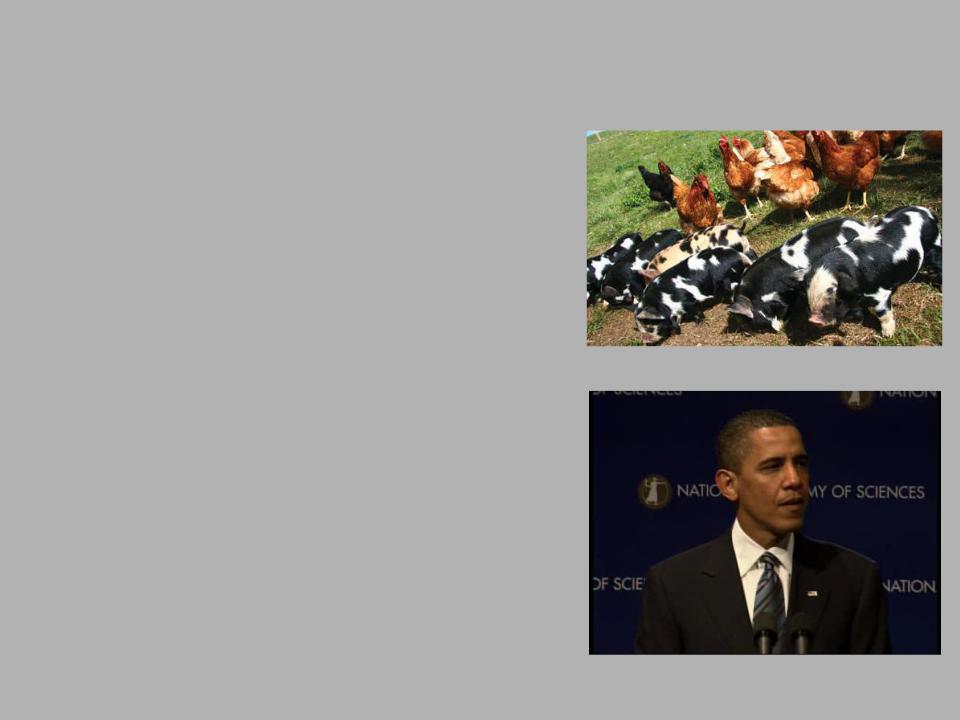
Вирусология / Orthomyxo-2011-20
.pdf
Definitions
General
•Epidemic – a located cluster of cases
•Pandemic – worldwide epidemic
•Antigenic drift
–Changes in proteins by genetic point mutation & selection
–Ongoing and basis for change in vaccine each year
•Antigenic shift
–Changes in proteins through genetic reassortment
–Produces different viruses not covered by annual vaccine

Survival of Influenza Virus
Surfaces and Affect of Humidity & Temperature*
•Hard non-porous surfaces 24-48 hours
–Plastic, stainless steel
•Recoverable for > 24 hours
•Transferable to hands up to 24 hours
•Cloth, paper & tissue
–Recoverable for 8-12 hours
–Transferable to hands 15 minutes
•Viable on hands <5 minutes only at high viral titers
–Potential for indirect contact transmission
*Humidity 35-40%, Temperature 28C (82F)
Source: Bean B, et al. JID 1982;146:47-51

Influenza
The Normal Burden of Disease
•Seasonal Influenza
–Globally: 250,000 to 500,000 deaths per year
–In the US (per year)
•~35,000 deaths
•>200,000 Hospitalizations
•$37.5 billion in economic cost (influenza & pneumonia)
•>$10 billion in lost productivity
•Pandemic Influenza
–An ever present threat

Swine Influenza A(H1N1)
Introduction
•Swine Influenza (swine flu) is a respiratory disease of pigs caused by type A influenza that regularly cause outbreaks of influenza among pigs
•Most commonly, human cases of swine flu happen in people who are around pigs
•Swine flu viruses do not normally infect humans, however, human infections with swine flu do occur, and cases of human-to-human spread of swine flu viruses have been documented

Swine Influenza A(H1N1)
History in US
•A swine flu outbreak in Fort Dix, New Jersey, USA occurred in 1976 that caused more than 200 cases with serious illness in several people and one death
–More than 40 million people were vaccinated
–However, the program was stopped short after over 500 cases of GuillainBarre syndrome, a severe paralyzing nerve disease, were reported
•30 people died as a direct result of the vaccination
•In September 1988, a previously healthy 32-year-old pregnant woman in Wisconsin was hospitalized for pneumonia after being infected with swine flu and died 8 days later.
•From December 2005 through February 2009, a total of 12 human infections with swine influenza were reported from 10 states in the United States

Swine Influenza A(H1N1)
Transmission Through Species
Human Virus
Avian Virus
Avian/Human
Reassorted Virus
Swine Virus
Reassortment in Pigs

Swine Influenza A(H1N1) March 2009
Timeline
•In March and early April 2009, Mexico experienced outbreaks of respiratory illness and increased reports of patients with influenza-like illness (ILI) in several areas of the country
•April 12, the General Directorate of Epidemiology (DGE) reported an outbreak of ILI in a small community in the state of Veracruz to the Pan American Health Organization (PAHO) in accordance with International Health Regulations
•April 17, a case of atypical pneumonia in Oaxaca State prompted enhanced surveillance throughout Mexico
•April 23, several cases of severe respiratory illness laboratory confirmed as influenza A(H1N1) virus infection were communicated to the PAHO
•Sequence analysis revealed that the patients were infected with the same strain detected in 2 children residing in California
–Samples from the Mexico outbreak match swine influenza isolates from patients in the United States
Source: CDC

Swine Influenza A(H1N1) March 2009
Facts
•Virus described as a new subtype of A/H1N1 not previously detected in swine or humans
•CDC determines that this virus is contagious and is spreading from human to human
•The virus contains gene segments from 4 different influenza types:
–North American swine
–North American avian
–North American human and
–Eurasian swine

Swine Influenza A(H1N1)
US Response
•The Strategic National Stockpile (SNS) is releasing one-quarter of its
–Anti-viral drugs
–Personal protective equipment and
–Reparatory protection devices
•President Obama today asked Congress for an additional $1.5 billion to fight the swine flu
•On April 27, 2009, the CDC issued a travel advisory that recommends against all non-essential travel to Mexico
Source: CDC

Swine Influenza A(H1N1)
Global Response
•The WHO raises the alert level to Phase 6
–WHO’s alert system was revised after Avian influenza began to spread in 2004 – Alert Level raised to Phase 3
–In Late April 2009 WHO announced the emergence of a novel influenza A virus
–April 27, 2009: Alert Level raised to Phase 4
–April 29, 2009: Alert Level raised to Phase 5
–June 11, 2008: Alert Level raised to Phase 6
Source: WHO
